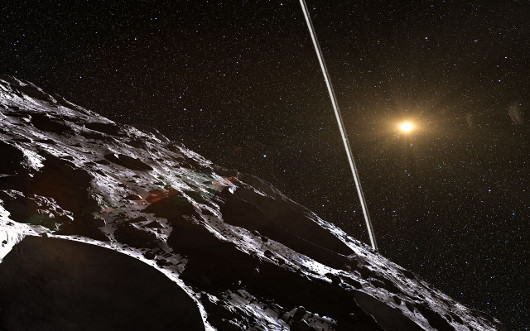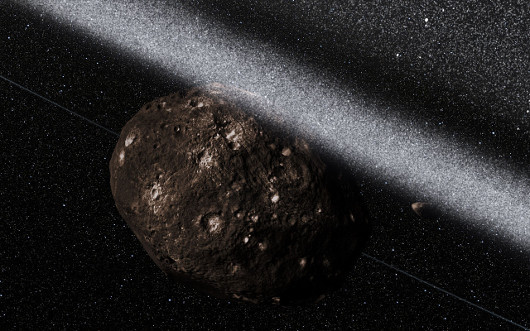20 seconds that changed our understanding of the Solar System
In the space of 20 seconds astronomers from the University of St Andrews made the surprising discovery of a double-ring system surrounding one of the many small objects in the Solar System. This object is the Centaur named “Chariklo”, which has a diameter of just about 250 km.

An artist’s impression of how the rings might look from close to the surface of Chariklo. Credit: ESO / L Calçada / Nick Risinger.
Until now Saturn has been widely known as the planet with the rings, while the only other rings were hitherto found around the remaining giant planets of the Solar System (Jupiter, Uranus, and Neptune).
The new research, reported today in the renowned journal “Nature”, suggests that the rings around Chariklo are partly composed of water ice.
Dr Martin Dominik, Royal Society University Research Fellow in the School of Physics & Astronomy of the University of St Andrews said:
We did not even dare to dream about finding a ring, let alone two. That took us by complete surprise, and we actually do not know why they are there.
The ring system could be detected because Chariklo was predicted to occult a star on 3 June 2013, visible during the night across South America.
Rather than just seeing the light from the star disappearing while Chariklo passes over it, further short interruptions were recorded from seven sites, from which the detailed properties of the ring system could be constructed.
Dr Dominik continued:
Everything happened within just 20 seconds. Resolving the rings, which are seven and three kilometres wide respectively, with an eight kilometre gap in between, only became possible by acquiring as many as ten image frames per second with our telescope in La Silla.
Dr Dominik is one of the co-leaders of the MiNDSTEp (Microlensing Network for the Detection of Small Terrestrial Exoplanets) consortium, using the Danish 1.54m telescope at the ESO site in La Silla (Chile) mainly to investigate the population of cold extra-solar planets using the technique of gravitational microlensing, but also to carry out several smaller “side projects”.
Dr Dominik added:
We deployed a high-speed camera in order to achieve higher angular resolutions by freezing in atmospheric turbulence, which then provides us with a sensitivity to planets down to the mass of the Moon. Apparently, it can be useful for other things as well.
The superior data set from this telescope was the only one that revealed that there is not just one ring, but two.
The present inferred orientation of the ring is consistent with its edge pointing towards us in 2008, providing a simple explanation for an earlier observed dimming of Chariklo between 1997 and 2008.

Artist’s impression of the view from inside the rings around Chariklo. Credit: ESO / L Calçada / M Kornmesser / Nick Risinger (skysurvey.org).
Scottish astronomer Dr Colin Snodgrass, now at the Max Planck Institute for Solar System Science in Germany, who analyzed the data in detail said:
During that dimming, signatures of water ice in its light spectrum disappeared. We therefore think that water ice is present in the rings.
In fact, observations from 2013 show that Chariklo has brightened as compared to 2008, and water ice has become detectable again.
However, the origin of the rings around Chariklo remains unknown, and whether other small Solar system objects have such rings as well remains a matter of speculation.
Dr Snodgrass said: “We do not know if rings around minor bodies stem from a generic, yet unknown, process, or are exceptional features.”
Possible scenarios include an impactor excavated icy material from Chariklo’s outer layer, destroying a preexisting satellite, or being disrupted itself. Alternatively, a disk could have formed from a rotational disruption or could have been fed by comets, two satellites might have collided, or a satellite might have migrated inwards and been disrupted.
Dr Dominik concluded:
This was one of the moments where you love being a scientist. You spent 20 seconds of telescope time, and find something puzzling that nobody expected. You usually have to wait quite a long time for the right 20 seconds, though…
Notes to news editors
Chariklo is the largest of the class of small objects in the Solar System known as “Centaurs”. These have unstable orbits that cross or have crossed the orbits of one or more of the giant planets (Jupiter, Saturn, Uranus, Neptune). Centaurs typically share some characteristics with asteroids and others with comets.
Details of Chariklo’s ring system:
- Ring 1: orbital radius 391 km, width 7 km
- Ring 2: orbital radius 405 km, width 3 km
- Radial separation: 14 km
- With of gap between rings: 8 km
The underlying scientific paper ‘A ring system detected around the Centaur (10199) Chariklo’ by F Braga-Ribas et al. has been scheduled for Advance Online Publication (AOP) on www.nature.com/nature. The DOI of the paper is 10.1038/nature13155.
Contacts:
Dr Martin Dominik, +44-7777-642564
Dr Colin Snodgrass, +49 173 711 9193
Category Research